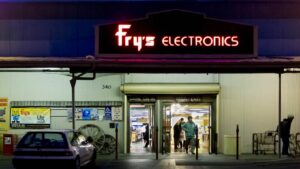The closure of Fry’s Electronics, a one-stop-shop for tech enthusiasts, left a significant void in the electronics retail landscape. However, as the saying goes, “nature abhors a vacuum.” In the wake of Fry’s departure, several contenders have stepped up to fill the gap.
What Replaced Fry’s Electronics

After Fry’s Electronics closed its doors, the landscape of electronic retail experienced a seismic shift. Several entities, both physical and online, rose to prominence, positioned themselves as primary sources for tech needs. Big-box retailers such as Best Buy, with its wide array of products, became a natural choice for consumers.
Amazon, a giant in e-commerce, capitalized on its expansive inventory and speedy delivery capabilities, took a substantial share of the market. At the same time, niche online platforms such as Newegg, with a unique focus on tech enthusiasts, also attracted significant patronage.
Simultaneously, the tech manufacturers’ own stores, such as Apple and Microsoft stores, offered a direct sales channel to their consumers, a change that hasn’t gone unnoticed in the retail industry.
Thus, electronic retail’s evolution reflects a diverse environment, a shift from a single destination to multiple platforms catering to the varied needs of tech patrons.
Background of Fry’s Electronics

Fry’s Electronics, established in 1985, played a key role as a prime conduit for tech enthusiasts. Headquartered in San Jose, California, the company grew from a mere local player into a significant national entity dominating the tech retail landscape across 31 stores. Besides its comprehensive array of electronic products ranging from software, hardware, to home appliances, Fry’s uniqueness manifested through themed concepts in each store, staging various aesthetics, like ‘Wild West’ or ‘Alien Invasion’. This, combined with a robust online presence, positioned Fry’s as a significant cornerstone in the tech retail industry. A crucial element contributing to its success involved the company’s knack for catering to specialist needs, satisfying not only average consumers but also tech aficionados, hobbyists, and professionals. Despite its popularity, Fry’s later grappled with several challenges, forcing its abrupt closure in 2021, a development that precipitated a considerable void in the electronic retail arena. Consequently, this set the stage for other entities to fill Fry’s position, marking a fundamental overhaul in the sector’s dynamics.
Impact on Consumers

Post Fry’s Electronics closure, consumers faced a change in their buying patterns. They saw themselves exploring new platforms for tech purchases, from traditional brick-and-mortar stores like Best Buy to online giants like Amazon and Newegg. Direct sales channels from tech manufacturers also made their mark, giving consumers the convenience of streamlined buying, minus the middleman. Despite the void left by Fry’s, consumers found themselves in a diverse environment, catering to various tech needs. It’s worth mentioning that personalized customer service, offered by Fry’s through its themed store concepts, posed a challenge for new platforms to match up. However, the digital native consumer base adapted well to this transformation, considering the accessibility and variety provided by these emerging retail spaces. In essence, Fry’s departure reshaped the electronics retail sector significantly, influencing consumer behavior while paving the way for a new tech retail landscape.
Future Trends in Electronic Retail
The demise of Fry’s Electronics has undeniably reshaped the electronic retail landscape. Best Buy, Amazon, Newegg, and direct sales channels from tech manufacturers have stepped up. They’ve not only filled the void but also diversified the market, catering to a wide range of tech needs. While the unique themes and personalized service of Fry’s are missed, the new retail environment has been embraced, especially by the digital native consumers. The shift has brought about a change in buying patterns, with consumers exploring new platforms for tech purchases. These emerging retail spaces offer accessibility and variety, which are key factors in influencing consumer behavior. As the industry continues to evolve, it’s clear that the future of electronic retail lies in diversity and digital transformation.

